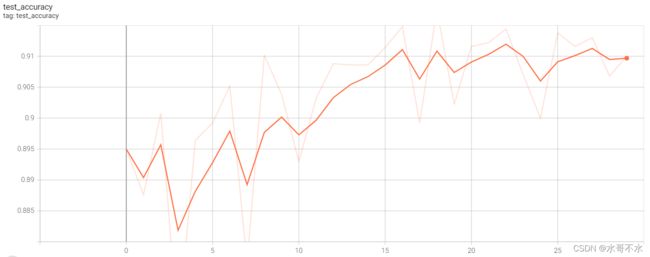Tensorflow---使用Tensorflow进行VGG模型的迁移学习和自定义训练
一、代码中所需的数据集可以通过以下链接进行下载
百度网盘提取码:lala
二、代码运行环境
Tensorflow-gpu==2.4.0
Python==3.7
三、数据的读取处理代码如下:
import tensorflow as tf
import os
import glob
import random
import matplotlib.pyplot as plt
# 环境变量的配置
os.environ['TF_XLA_FLAGS'] = '--tf_xla_enable_xla_devices'
os.environ['TF_FORCE_GPU_ALLOW_GROWTH'] = 'true'
label_to_index = {
'cat': 0,
'dog': 1
}
index_to_label = {
0: 'cat',
1: 'dog'
}
# 进行图片的解析,同时进行图片增强
def train_load_image_by_path(path, label):
img = tf.io.read_file(path)
img = tf.image.decode_jpeg(img, channels=3)
img = tf.image.resize(img, [360, 360])
img = tf.image.random_crop(img, [256, 256, 3]) # 随机裁剪
img = tf.image.random_flip_left_right(img) # 随机左右翻转
img = tf.image.random_flip_up_down(img) # 随机上下翻转
# img = tf.image.random_brightness(img, 0.5) # 随机改变亮度
# img = tf.image.random_contrast(img, 0, 1) # 随机改变图像的对比度
img = tf.cast(img, tf.float32)
img = img / 255.0
label = [tf.cast(label, tf.int64)]
return img, label
# 进行图片的解析
def test_load_image_by_path(path, label):
img = tf.io.read_file(path)
img = tf.image.decode_jpeg(img, channels=3)
img = tf.image.resize(img, [256, 256])
img = tf.cast(img, tf.float32)
img = img / 255.0
label = [tf.cast(label, tf.int64)]
return img, label
# 数据的提取
def make_dataset():
train_image_path = glob.glob('dataset/train/*.jpg')
random.shuffle(train_image_path)
train_image_label = [label_to_index.get(img_path.split('\\')[1].split('.')[0]) for img_path in train_image_path]
dataset = tf.data.Dataset.from_tensor_slices((train_image_path, train_image_label))
count = len(train_image_path)
test_count = int(count * 0.2)
train_dataset = dataset.skip(test_count)
test_dataset = dataset.take(test_count)
train_dataset = train_dataset.map(train_load_image_by_path, num_parallel_calls=tf.data.experimental.AUTOTUNE)
train_dataset = train_dataset.shuffle(100).batch(16)
train_dataset = train_dataset.prefetch(tf.data.experimental.AUTOTUNE)
test_dataset = test_dataset.map(test_load_image_by_path, num_parallel_calls=tf.data.experimental.AUTOTUNE)
test_dataset = test_dataset.batch(16)
test_dataset = test_dataset.prefetch(tf.data.experimental.AUTOTUNE)
return train_dataset, test_dataset
if __name__ == '__main__':
train_data, test_data = make_dataset()
for imgg, labeel in test_data.take(1):
plt.title(index_to_label.get(labeel.numpy()[0][0]))
plt.imshow(imgg[0])
plt.show()
四、模型的构建如下:
import tensorflow as tf
import os
# 环境变量的配置
os.environ['TF_XLA_FLAGS'] = '--tf_xla_enable_xla_devices'
os.environ['TF_FORCE_GPU_ALLOW_GROWTH'] = 'true'
# 进行模型的构建
def make_model():
conv_base = tf.keras.applications.VGG16(weights='imagenet', include_top=False)
model = tf.keras.Sequential()
model.add(conv_base)
model.add(tf.keras.layers.GlobalAveragePooling2D())
model.add(tf.keras.layers.Dense(512, activation='relu'))
model.add(tf.keras.layers.Dense(1, activation='sigmoid'))
conv_base.trainable = False
model.summary()
return model
if __name__ == '__main__':
make_model()
五、模型的训练如下:
import tensorflow as tf
import os
from data_loader import make_dataset
from model import make_model
import tqdm
import datetime
# 环境变量的配置
os.environ['TF_XLA_FLAGS'] = '--tf_xla_enable_xla_devices'
os.environ['TF_FORCE_GPU_ALLOW_GROWTH'] = 'true'
# 数据的加载
train_dataset, test_dataset = make_dataset()
# 模型的构建
my_model = make_model()
# 模型的相关配置
loss_func = tf.keras.losses.BinaryCrossentropy()
optimizer = tf.keras.optimizers.Adam()
# 评估指标
train_loss_mean = tf.keras.metrics.Mean('train_loss')
train_accuracy = tf.keras.metrics.Accuracy('train_accuracy')
test_loss_mean = tf.keras.metrics.Mean('test_loss')
test_accuracy = tf.keras.metrics.Accuracy('test_accuracy')
# 日志写入定义
run_now_time = datetime.datetime.now().strftime('%Y-%m-%d---%H-%M-%S')
log_dir = os.path.join('logs', run_now_time)
train_writer = tf.summary.create_file_writer(logdir=log_dir + 'train')
test_writer = tf.summary.create_file_writer(logdir=log_dir + 'test')
NUM_EPOCHS = 30
# 定义单步训练
def train_steps(model, images, labels):
with tf.GradientTape() as t:
pre = model(images)
loss_step = loss_func(labels, pre)
grads = t.gradient(loss_step, model.trainable_variables)
optimizer.apply_gradients(zip(grads, model.trainable_variables))
train_loss_mean(loss_step)
train_accuracy(labels, tf.cast(pre > 0.5, tf.int32))
# 定义单步测试
def test_steps(model, images, labels):
pre = model(images)
loss_step = loss_func(labels, pre)
test_loss_mean(loss_step)
test_accuracy(labels, tf.cast(pre > 0.5, tf.int32))
def train():
for epoch in range(NUM_EPOCHS):
train_tqdm = tqdm.tqdm(iter(train_dataset), total=len(train_dataset))
for image, label in train_tqdm:
train_steps(my_model, image, label)
train_tqdm.set_description_str('Epoch: {}'.format(epoch))
train_tqdm.set_postfix_str(
'Train loss : {} Train accuracy is : {}'.format(train_loss_mean.result(), train_accuracy.result()))
with train_writer.as_default():
tf.summary.scalar('train_loss', data=train_loss_mean.result(), step=epoch)
tf.summary.scalar('train_accuracy', data=train_accuracy.result(), step=epoch)
train_tqdm.close()
train_loss_mean.reset_states()
train_accuracy.reset_states()
test_tqdm = tqdm.tqdm(iter(test_dataset), total=len(test_dataset))
for image_test, label_test in test_tqdm:
test_steps(my_model, image_test, label_test)
test_tqdm.set_description_str('Epoch: {}'.format(epoch))
test_tqdm.set_postfix_str(
'Test loss : {} Test accuracy is : {}'.format(test_loss_mean.result(), test_accuracy.result()))
with test_writer.as_default():
tf.summary.scalar('test_loss', data=test_loss_mean.result(), step=epoch)
tf.summary.scalar('test_accuracy', data=test_accuracy.result(), step=epoch)
test_tqdm.close()
test_loss_mean.reset_states()
test_accuracy.reset_states()
if __name__ == '__main__':
train()
六、模型预测代码如下:
import tensorflow as tf
import os
from data_loader import index_to_label
import matplotlib.pyplot as plt
# 环境变量的配置
os.environ['TF_XLA_FLAGS'] = '--tf_xla_enable_xla_devices'
os.environ['TF_FORCE_GPU_ALLOW_GROWTH'] = 'true'
# 模型的加载
my_model = tf.keras.models.load_model(r'model_data/model.h5')
# 图片的读取
def load_image(path):
image = tf.io.read_file(path)
image = tf.image.decode_jpeg(image, channels=3)
image = tf.image.resize(image, [256, 256])
image = tf.cast(image / 256, tf.float32)
return image
# 进行预测
while True:
input_path = input('请输入图片路径:\n')
try:
img = load_image(input_path)
except:
print('路径输入不正确!\n')
continue
else:
plt.imshow(img)
img = tf.expand_dims(img, 0)
pre = my_model(img)
plt.title(index_to_label.get(tf.cast(pre > 0.5, tf.int32).numpy()[0][0]))
plt.show()




